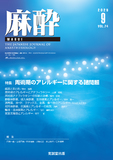Japanese
English
- 有料閲覧
- Abstract 文献概要
- 1ページ目 Look Inside
- 参考文献 Reference
はじめに
免疫反応は,外来の異物(抗原)を排除するために働く,生体にとって不可欠な生理機能である。特定の抗原に対する過剰反応(蕁麻疹,瘙痒感,呼吸困難,血圧低下など)をアレルギー反応といい,特に反応が激しく,全身性のものはアナフィラキシーと呼ばれる。周術期には多くの薬物が使用され,これらによるアナフィラキシーの発生頻度は約0.01%といわれている1)~3)。原因となる薬物の多くは静脈麻酔薬,局所麻酔薬,筋弛緩薬,抗菌薬,造影剤,血液製剤,および薬液に含まれる防腐剤などが報告されている1)~4)。本論文では,上記の薬物のうち輸液製剤および輸血製剤に関するアレルギー性反応の頻度,発生機序,検査,予防,治療などについて解説する。
All medicinal products, including transfusion and blood products, have the potential to elicit allergic reactions, including anaphylaxis. Reports of anaphylactic reactions induced by transfusion products are very rare, but transfusion products should be considered in differential diagnoses of anaphylactic reactions as one of the potential causative agents. Allergic reactions are the most frequent adverse reaction to blood transfusions. In cases of fatal blood transfusion-related allergic reactions, the basophil activation test(BAT)is performed in addition to assessments of the patient’s tryptase and plasma protein deficiency and antibody tests to search for the reaction’s cause. Repeat cases of an allergic reaction can be prevented by the administration of washed platelet cells or washed red blood cell products, but care should be taken as some washing methods may lead to a qualitative deterioration of the product and not achieve the expected increase in platelet count after transfusion. It is essential to be familiar with the latest transfusion information, as new laboratory tests, including the BAT, are being introduced to improve the safety of transfusion medicine, and research is focusing on clarifying the exact mechanisms that underlie the occurrence of allergic reactions to transfusion products and blood transfusion products.

Copyright © 2025 KOKUSEIDO CO., LTD. All Rights Reserved.


